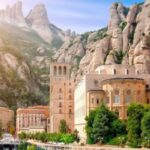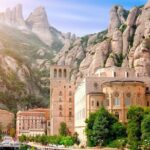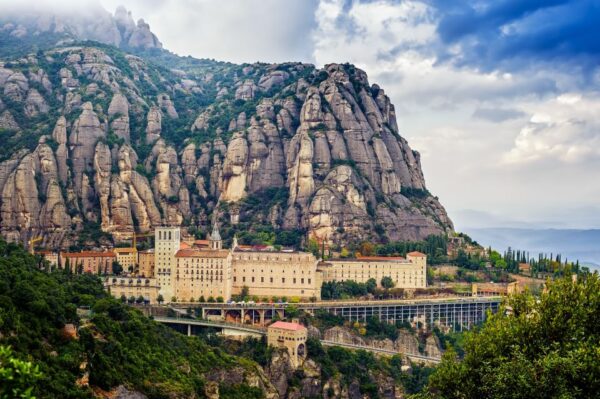
Catalonia is a region rich in history, spirituality, and cultural vibrancy, making it a captivating destination for travelers seeking both enlightenment and inspiration. One of the highlights of this journey begins at the stunning Montserrat Monastery, perched atop a mountain and steeped in religious significance.
As we traverse the landscape from Montserrat Monastery to Barcelona: Exploring Catalonia's Spiritual and Cultural Wonders, we uncover a tapestry of art, architecture, and tradition that showcases the soul of this remarkable region. Each stop along the way offers a unique glimpse into Catalonia's diverse heritage, inviting visitors to immerse themselves in its timeless beauty.
Spiritual Significance of Montserrat Monastery in Catalonia
The Spiritual Significance of Montserrat Monastery in Catalonia is profound, as it serves as a pilgrimage site for countless devotees. Nestled amidst breathtaking natural scenery, the monastery is dedicated to the Virgin of Montserrat, a revered figure in Catalan spirituality. This unique location has long been a beacon of faith, drawing visitors to seek solace, guidance, and inspiration in its tranquil environment.
Visitors to Montserrat often engage in various spiritual practices, including:
- Attending mass and participating in religious ceremonies
- Walking the many trails that lead to scenic viewpoints
- Reflecting in the peaceful gardens surrounding the monastery
- Experiencing the liturgical music of the famous boys' choir, known as "Escolania"
The monastery’s historical significance is also noteworthy, as it has been a center of learning and culture since its founding in the 10th century. Its libraries and archives preserve numerous ancient texts, contributing to the intellectual and spiritual legacy of Catalonia. This rich history enhances the spiritual experience for visitors, making Montserrat not just a place of worship, but a living museum of Catalan heritage.
Additionally, Montserrat Monastery is often viewed as a symbol of Catalonia's identity, representing resilience and faith. The stunning rock formations that surround it reflect the strength and beauty of the region, inviting visitors to connect with both the land and their spirituality. This connection fosters a sense of unity and purpose, enhancing the overall experience for those who venture to this sacred site.
Cultural Heritage: Discovering the Rich Traditions of Catalonia
Catalonia's cultural heritage is a vibrant tapestry woven from centuries of history, art, and tradition. The region boasts a unique blend of influences that reflect its complex past and rich identity. From the architectural marvels of Antoni Gaudí to the traditional festivals celebrated in every town, Catalonia offers a fascinating glimpse into the heart of its cultural landscape.
One of the most iconic aspects of Catalonia's cultural heritage is its language and literature. The Catalan language, with its distinct dialects, serves as a vital expression of regional identity. Literary figures such as Mercè Rodoreda and Joan Maragall have contributed significantly to Catalan literature, enriching the cultural fabric of the region. These literary traditions are celebrated through various literary festivals, showcasing the importance of storytelling in Catalan culture.
Additionally, Catalonia is renowned for its vibrant traditions, which include a variety of unique festivals and culinary delights. Among the most notable are:
- Castells - Human towers that symbolize both unity and strength, often constructed during local celebrations.
- La Diada de Sant Jordi - A day honoring the patron saint of Catalonia, celebrated with roses and books exchanged between lovers.
- Traditional Catalan cuisine - Featuring dishes like pa amb tomàquet (bread with tomato) and calçots (grilled green onions), reflecting the region's agricultural bounty.
In exploring Catalonia's cultural heritage, visitors can immerse themselves in the diverse artistic expressions found in museums, galleries, and public spaces. From the vibrant works of modern artists to the timeless masterpieces of the past, Catalonia stands as a testament to the enduring spirit of creativity that defines its people. This rich cultural heritage not only enhances the visitor experience but also fosters a deeper understanding of the Catalan identity.
The Iconic Landscapes of Montserrat: Nature's Spiritual Canvas
The iconic landscapes of Montserrat are nothing short of breathtaking, offering a natural backdrop that has inspired countless pilgrims and artists alike. The rugged peaks, dramatic cliffs, and serene valleys create a spiritual ambiance that enhances the experience of those who visit. This unique environment serves as a canvas for both the physical and metaphysical, inviting contemplation and reverence.
Among the remarkable features of Montserrat's landscape are:
- Jagged Rock Formations - The distinct Montserrat massif, shaped by erosion, is both a geological wonder and a spiritual symbol.
- Lush Forests - Surrounding the monastery, these forests provide a tranquil setting for reflection and meditation.
- Panoramic Views - The various viewpoints offer breathtaking vistas of the Catalan countryside, enhancing the connection between nature and spirituality.
As visitors explore Montserrat, they may find themselves walking along trails that lead to sacred sites, each path offering a different perspective on the landscape. The interplay of light and shadow on the cliffs creates a dynamic visual experience that changes throughout the day, reinforcing the idea that nature itself is a spiritual canvas, constantly in flux and ever inspiring.
This extraordinary setting not only captivates the senses but also serves as a reminder of the deep-rooted connection between spirituality and the natural world. The landscapes of Montserrat inspire visitors to contemplate their own journeys, encouraging a sense of peace and connection that resonates long after they leave this sacred site.
Exploring Barcelona's Cultural Landmarks: A Journey Through History
Barcelona is a city that pulsates with a rich tapestry of history and culture, making it an essential stop on any journey through Catalonia. As you wander its streets, you’ll encounter landmarks that tell stories of the past, from the Roman ruins that date back to the 1st century to the stunning Gothic architecture of the Barcelona Cathedral. Each site not only showcases the city's architectural prowess but also serves as a testament to its enduring spirit and resilience.
Among the highlights of Barcelona's cultural landmarks is the famed Sagrada Família, an iconic basilica designed by Antoni Gaudí. This masterpiece, still under construction, is a striking example of modernist architecture, with its intricate facades and soaring spires attracting millions of visitors annually. Not far from here, the historic Barri Gòtic (Gothic Quarter) invites exploration, where narrow medieval streets lead to hidden squares, each revealing the city’s layered history.
Another remarkable site is Park Güell, another Gaudí creation that blends natural beauty with artistic genius. The park is adorned with colorful mosaics and whimsical structures that reflect Gaudí's unique vision, providing a space for both relaxation and inspiration. Visitors can enjoy panoramic views of the city, further enriching their understanding of Barcelona's landscape and cultural heritage.
To fully appreciate Barcelona's cultural heritage, consider exploring its vibrant museums, such as the Picasso Museum and the National Art Museum of Catalonia. These institutions house extensive collections that celebrate the region's artistic evolution, showcasing works that span centuries and styles. Engaging with these cultural landmarks allows travelers to connect with the historical narratives that have shaped Barcelona into the dynamic city it is today.
Catalonia's Spiritual Pilgrimage Routes: From Montserrat to Barcelona
Catalonia's spiritual pilgrimage routes offer a profound journey that begins at the iconic Monsrat Monastery and leads to the vibrant city of Barcelona. This path is not only a physical trek but also a journey of self-discovery and connection with the rich spiritual heritage of the region. Pilgrims and travelers alike are drawn to the serene landscapes and sacred sites that dot the route, each offering a unique opportunity for reflection and connection with the divine.
Along the way, visitors can explore various significant stops that embody the spiritual essence of Catalonia. Key highlights include:
- Montserrat Monastery - A center of spirituality and community, where visitors can engage in prayer and meditation.
- Santa Maria de Manresa - A historical site linked to St. Ignatius of Loyola, known for its transformative atmosphere.
- Church of Sant Cugat - An architectural gem that showcases the region's rich ecclesiastical history.
The journey from Montserrat to Barcelona weaves through diverse landscapes, allowing pilgrims to experience the breathtaking beauty of Catalonia's countryside. The stunning vistas serve as a reminder of the spiritual connection between nature and faith, enhancing the pilgrimage experience. As each step brings travelers closer to their destination, they are encouraged to contemplate their personal journeys, fostering a deeper understanding of their spirituality.
Ultimately, the spiritual pilgrimage routes in Catalonia offer more than just a pathway between two significant locations; they provide an immersive experience that intertwines faith, culture, and history. By engaging with the sites along the way, visitors can develop a personal connection to the rich tapestry of Catalonia’s spiritual heritage, making this journey a memorable and transformative adventure.
Art and Architecture: The Marvels of Catalonia's Sacred Sites
Catalonia's sacred sites are not only spiritual havens but also masterpieces of art and architecture that reflect the region's rich cultural heritage. From the intricate designs of the Sagrada Família by Antoni Gaudí to the stunning Romanesque features of the Monastery of Sant Cugat, each structure tells a story of faith interwoven with artistry. The distinct styles, ranging from Gothic to Modernisme, offer visitors a visual feast that highlights the evolution of Catalan architecture.
Notable architectural marvels include:
- Montserrat Monastery - A blend of natural beauty and religious devotion, featuring stunning stone carvings and breathtaking vistas.
- Barcelona Cathedral - An exemplary Gothic structure known for its soaring spires and intricate facades.
- Santa Maria del Mar - A beautiful example of Catalan Gothic architecture, celebrated for its serene interior and stunning stained glass.
Artistic expressions are equally significant, with many sacred sites housing invaluable collections. For instance, the Picasso Museum and the National Art Museum of Catalonia feature works that showcase the artistic evolution of Catalonia, enriching visitors’ understanding of the spiritual narratives that these sites embody. Furthermore, the integration of art within these architectural wonders creates a harmonious environment for contemplation and connection.
As visitors explore these cultural treasures, they are invited to reflect on the profound relationship between spirituality and creativity in Catalonia. The intricate carvings, frescoes, and mosaics found throughout these sites serve as a testament to the devotion of artists and architects alike, making each visit a transformative experience that resonates deeply with the soul.
 From Montserrat Monastery to Sant Jeroni: A Scenic Hike in Barcelona's Stunning Mountain Range
From Montserrat Monastery to Sant Jeroni: A Scenic Hike in Barcelona's Stunning Mountain Range Discover the Splendor of Montserrat Monastery: A Guided Tour from Barcelona
Discover the Splendor of Montserrat Monastery: A Guided Tour from Barcelona Discover the Magic of Montserrat Monastery: A Tripadvisor Guide
Discover the Magic of Montserrat Monastery: A Tripadvisor GuideIf you want to know other articles similar to From Montserrat Monastery to Barcelona: Exploring Catalonia's Spiritual and Cultural Wonders you can visit the category WHERE YOU CAN GO.
Leave a Reply










Read more!